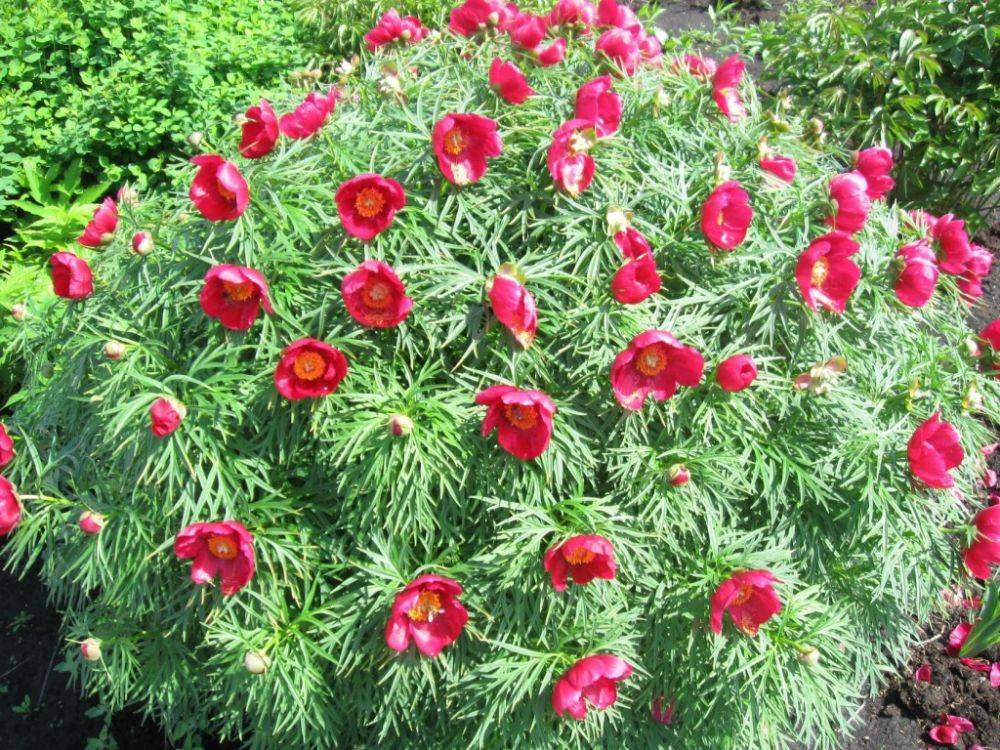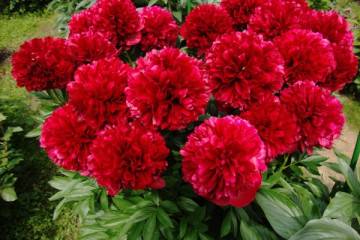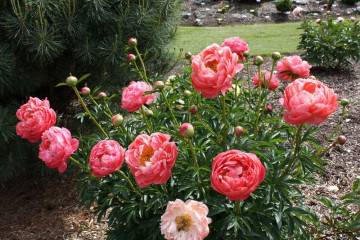Peony evading (Maryin root) - growing in the garden
Content:
The plant, called the evading peony, is listed in the Red Book of the Russian Federation and it is almost impossible to find it in nature. This herbaceous perennial with medicinal properties can be grown in the garden. It is used in folk medicine as a tincture, looks great in home cut, has melliferous properties.
Evasive peony (Maryin root): description and characteristics
Evasive peony (Paeonia Anomala, aka Maryin root or Maryina grass) is a herbaceous perennial plant that is part of the Peony family. In nature, the flower grows in the Altai Territory, on the mountain slopes of East Asia. In Russia, its habitat is Siberia and the Komi Republic.
Its stems are convex-ribbed, pink-purple at the ground, stretching up to 1.5 meters in height, covered with patterned dark green leaves along their entire length. Flowers from 8 to 13 cm in diameter are painted in a deep pink color, the middle is bright yellow. The root system is tuberous, reddish-brown on the outside and white on the cut. The roots of the plant taste sweet and have a characteristic odor. The plant has an approximate lifespan of 25–30 years.
Maryina grass is a useful flower, contains many biologically active substances and has a number of medicinal properties. Parts of the plant are used as a traditional method of treatment for mental overload. Medicine is considering a plant to create various drugs:
- relieving spasms and cramps;
- pain relievers;
- alleviating the condition with nervous excitability;
- normalizing the work of the circulatory system;
- used in the fight against viral diseases.
Tinctures, which include the root of the evading peony, help in the treatment of gastritis, getting rid of colic and diarrhea. Also, the peony Maryin root stimulates metabolic processes, helps to increase the acidity of the stomach, and serves as a prophylactic agent for the appearance of malignant tumors.
The evading peony has found its application not only in folk medicine. The plant is a good honey plant. It is used in the preparation of the drink "Baikal". In Siberia, the dried roots of Maryina's grass are classified as homemade spices and are added to meat dishes to add aroma and taste. In Kazakhstan, the seasoning is put into porridge, and in Mongolia it is brewed as tea.
Gardeners appreciate the plant for its decorative qualities. It is often planted as part of landscape compositions for the improvement of summer cottages and personal plots.
How to properly plant and grow a flower in the open field
The evading peony propagates by rhizomes and sowing seeds. The main condition is adherence to agricultural technology. The first option is much easier and faster, which is why gardeners prefer it.
Planting with rhizome cuttings
The bush is carefully removed from the ground, the soil is cleaned from the roots and divided into several, approximately equal parts. Each of the divisions must have its own roots and 2-5 pieces. kidneys.
What time is the boarding
The procedure is carried out in the autumn. It is important to take into account that the plant should have enough time to adapt to a new place within 30-45 days before the onset of frost.
Location selection
Maryin root is a wild plant, not too picky about the composition of the soil and external conditions. For the plant, open to the sun, as well as shaded areas protected from drafts, are suitable. The bush takes root very well under trees.
How to prepare the soil and flower for planting
Delenki are dried in the fresh air by treating the root sections with ash. The site for planting is dug up with the addition of superphosphate and potassium, as well as river sand, which gives the soil looseness.
Planting procedure step by step
Mar'in root is planted on a site prepared in advance. The instructions for the landing sequence are as follows:
- For each seedling, dig holes with a diameter of at least 50 cm and a depth of 2 shovel bayonets.
- A drainage layer is placed at the bottom of the pit.
- The pits are half filled with a soil mixture prepared from equal parts of humus, sand and garden soil.
- The bush is placed in a hole, gently spreading the roots, and covered with earth.
- The planted plants are watered.
In the first years after planting, the bush is regularly pinched so that it has the opportunity to fully develop. To support the overgrown plant, a support is built around it, to which the stems are tied.
Seed planting
This breeding method is very laborious. Seeds are stratified at home for 7.5 months. To do this, they are placed in a small container filled with wet sand and stored for 2.5 months at a temperature of 20 ⁰C. For the remaining 5 months, the seed should be in the refrigerator. Next, the container is exposed to heat and begins to water regularly - after a while, shoots will appear. The seedlings are transferred to open ground after 2 years.
Plant care Maryina grass
It is easy to care for a peony evading. Even with minimal care, the plant will surely delight you with its flowers.
Watering and feeding
Maryin root does not need frequent watering, as its tuberous roots can accumulate moisture. During the growing season and at the end of summer, when flower buds are laid, 1-2 buckets of water should be poured under the bush. It is important to remember that roots can rot from excessive waterlogging. To drain excess moisture from the trunk circle, small grooves are made around.
It is best to feed young plants with mineral fertilizers, applying them by the foliar method no more than 1 time per month. Adult bushes need additional nutrition three times per season. In the spring, the peony is fertilized with a urea solution, at the beginning of summer with the same composition with the addition of a mineral complex, after another 3 weeks, only minerals are added.
Mulching and loosening
The evading peony is protected from overgrowing with weeds and is regularly loosened after watering or rain. This will protect the plant from disease and provide oxygen to the roots. The loosening depth should be 5-15 cm.
Preventive treatment
To scare away insect pests from Maryin, in the spring it can be sprayed with fungicidal preparations. It will not be superfluous to shed the soil in the near-trunk circle with a solution of Bordeaux liquid.
Blooming peony
The evading peony takes effect and begins to bloom about 2-3 years after planting. With age, the plant is covered with more and more buds, the color intensity of which becomes richer.
A period of activity and rest
The flowering period occurs in May-June and lasts for 2 weeks. It is at this time that the leaves of the plant are harvested to be used for medicinal purposes. The fruits of Maryina's grass appear in August.
Care during and after flowering
When Maryin's root blooms, faded buds should be removed from it in a timely manner. This, although not for long, will prolong the flowering period.
What to do if it does not bloom, possible reasons
The evading peony stops blooming if the technology of planting and cultivation is grossly violated. Most often, inexperienced growers make the following mistakes:
- When transplanting a bush, do not divide it into several parts.
- The bush is deeply buried in the soil.
Peonies after flowering
The bush can be transplanted only after the end of the flowering period. If the flower does not look sick and there is no need to urgently transfer it to a new place, then it is better to postpone the event until September.
Transfer
A transplant is not recommended to be done more often than once every 3 years, and only when really necessary. In this case, the roots must be divided and deepened during planting by no more than 5 cm.
Pruning
The procedure for pruning a plant is carried out in the fall, shortly before the onset of winter cold weather. Leaves and stems are completely cut from the bush to a height of 10 cm, composted or burned.
Preparing for winter
In young plants, the aerial parts remaining after pruning are sprinkled with ash and covered with spruce branches. Adult shrubs of the dodging peony do not need winter shelter.
Diseases, pests and ways to control them
The evading peony has good immunity against various diseases. However, gray mold can attack its roots sensitive to moisture levels. To prevent the appearance of the disease, the bushes of Maryin's root are watered in the spring three times with an interval of 2 weeks with a solution of fungicidal preparations (Maxim, Fitosporin-M). Rust is also a danger, which can be protected by spraying with a solution of colloidal sulfur.
Pests
Of the pests, you should beware of bronzes, aphids, ants. They are disposed of with folk remedies and insecticidal compositions, using them strictly according to the instructions.
It is important to remember that any problems appear only if the rules of landing and leaving are violated. With the knowledge and use of the simplest agricultural technology, the cultivation of a peony evading in a personal plot will not cause any special difficulties and hassle.




















